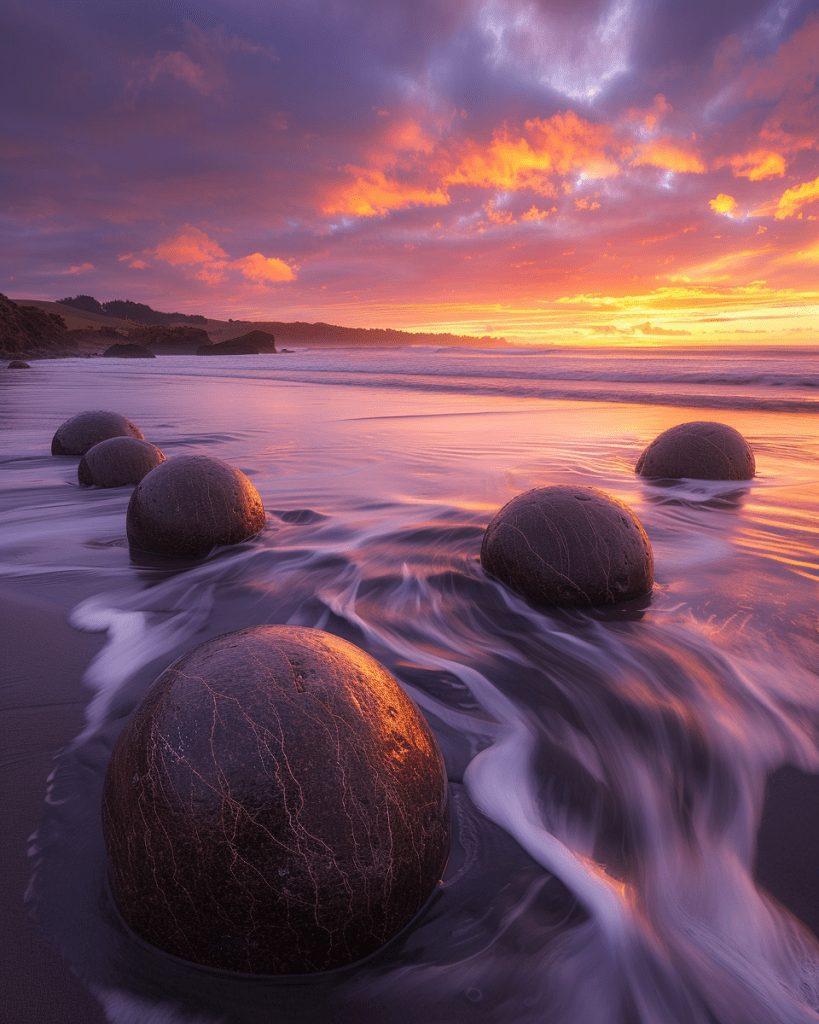Along the scenic Otago coast of New Zealand lies a truly captivating natural wonder – the Moeraki Boulders. These perfectly spherical stones, scattered across Koekohe Beach, have fascinated visitors for generations.
The Moeraki Boulders are unusually large spherical boulders formed over 60 million years ago, measuring up to 2 meters in diameter. Their near-perfect roundness and impressive size make them a unique geological formation that draws tourists from around the world.
Steeped in both scientific intrigue and Māori legend, these boulders offer more than just a pretty sight.
Visitors can explore the beach at low tide, touch the smooth surface of the boulders, and marvel at the forces of nature that created them.
Whether one is interested in geology, photography, or simply enjoying a beautiful coastal landscape, the Moeraki Boulders provide an unforgettable experience.
Geological Marvel
The Moeraki Boulders are a remarkable geological phenomenon, captivating visitors with their unique formation and structure. These spherical stones showcase nature’s ability to create extraordinary shapes through slow, methodical processes.
Formation
The Moeraki Boulders formed over millions of years through a process called concretion.
This occurs when mineral-rich sediments, often organic material like plant matter or shells, accumulate around a central core.
As layers build up over time, they create increasingly larger spheres. The process is incredibly slow, with estimates suggesting the boulders took 4 to 5.5 million years to reach their current size.
Originally buried in mudstone cliffs, coastal erosion gradually exposed these geological wonders. As the softer surrounding material wears away, the harder boulders emerge and tumble onto the beach.
Composition and Structure
The Moeraki Boulders are primarily composed of mud, fine silt, and clay, cemented together by calcite.
Their internal structure is fascinating, often revealing septarian cracks filled with calcite and dolomite crystals.
These cracks create intricate patterns visible when boulders split open, resembling dragon eggs or turtle shells. The boulders range in size from about 0.5 to 2.2 meters in diameter.
Their nearly perfect spherical shape is a testament to their uniform formation. The outer layer is typically harder than the interior, helping them maintain their round form as they weather.
Cultural and Historical Significance
The Moeraki Boulders hold deep cultural meaning for the Māori people and have intrigued scientists for generations. These unique spherical formations have inspired legends and sparked scientific curiosity.
Maori Legends
The Moeraki Boulders play a significant role in Māori mythology. According to traditional stories, these boulders are believed to be the physical manifestation of ancestral spirits who traveled on the Araiteuru canoe.
The Māori people consider the boulders to contain the mauri, or life force, of their ancestors. This connection makes the site a crucial link to their cultural heritage.
In some versions of the legend, the boulders are described as eel pots or baskets of kūmara (sweet potato) that washed ashore from the Ārai-te-uru voyaging canoe. These stories highlight the boulders’ importance in Māori oral tradition.
Research and Studies
Scientific interest in the Moeraki Boulders has led to extensive research over the years.
Geologists have determined that these unusually large spherical boulders formed naturally about 60 million years ago.
Studies show the boulders are concretions created from sediment and calcite. This process occurred on the seafloor, with the boulders later exposed by coastal erosion.
Researchers continue to examine the boulders’ unique formation process. Their work helps shed light on geological processes and the Earth’s history in the Otago region.
The site attracts geologists and tourists alike, fostering both scientific understanding and public appreciation of these natural wonders.
Visitor Information
The Moeraki Boulders offer a unique geological experience for travelers. Visitors can enjoy easy access, optimal viewing times, and participate in conservation efforts.
Location and Accessibility
The Moeraki Boulders are located on Koekohe Beach, between the towns of Moeraki and Hampden in the South Island of New Zealand.
They are easily accessible via State Highway 1, about 40 km south of Oamaru.
Visitors can park at the Moeraki Boulders Café and take a short boardwalk to the beach. The walk from the café to the boulders takes about 5-7 minutes.
Access is also possible from Hampden Beach to the south for those preferring a longer stroll. This option provides a scenic coastal walk to the boulders.
Best Time to Visit
The ideal time to visit the Moeraki Boulders is during low tide.
This allows visitors to walk around the boulders safely and take unobstructed photographs.
Early morning or late afternoon visits offer the best lighting conditions for photography.
The soft light during these times enhances the boulders’ unique features and creates stunning shadows.
Visiting during sunrise or sunset can be particularly magical, as the golden light illuminates the spherical stones beautifully.
It’s advisable to check local tide tables before planning a visit to ensure the best viewing experience.
Conservation Efforts
Preservation of the Moeraki Boulders is crucial to maintaining their natural beauty and scientific value.
Visitors are asked to follow some simple guidelines:
- Do not climb on or remove any part of the boulders
- Stay on designated paths to minimize erosion
- Take only photographs and leave only footprints
Local authorities have installed information boards to educate visitors about the boulders’ geological significance and the importance of conservation.
Volunteers occasionally organize beach clean-ups to keep the area pristine. Visitors can contribute by picking up any litter they find during their visit.

